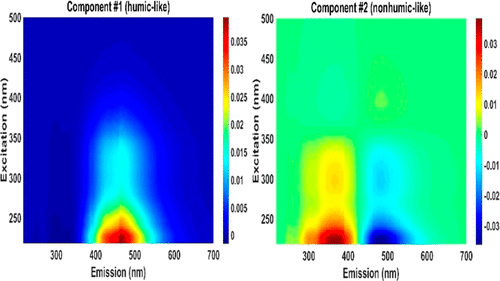当前位置:
X-MOL 学术
›
Environ. Sci. Technol.
›
论文详情
Our official English website, www.x-mol.net, welcomes your
feedback! (Note: you will need to create a separate account there.)
Fluorescence and Quenching Assessment (EEM-PARAFAC) of de Facto Potable Reuse in the Neuse River, North Carolina, United States
Environmental Science & Technology ( IF 10.8 ) Pub Date : 2017-11-17 00:00:00 , DOI: 10.1021/acs.est.7b03766 Martha J. M. Wells 1 , Gene A. Mullins 2 , Katherine Y. Bell 3 , Allegra K. Da Silva 4 , Eileen M. Navarrete 5
Environmental Science & Technology ( IF 10.8 ) Pub Date : 2017-11-17 00:00:00 , DOI: 10.1021/acs.est.7b03766 Martha J. M. Wells 1 , Gene A. Mullins 2 , Katherine Y. Bell 3 , Allegra K. Da Silva 4 , Eileen M. Navarrete 5
Affiliation

|
The Neuse River, North Carolina, U.S., exemplifies a typical de facto potable reuse scenario, where drinking water sources are located downstream of treated wastewater effluent discharges. The study results imply that planned potable water reuse, whether in an indirect or direct potable reuse scenario, might provide better control over water quality than the status quo conditions. Using fluorescence excitation–emission matrix (EEM) measurements, anthropogenic influence of a wastewater treatment plant (WWTP) discharge was observed in samples near the location of drinking water treatment plant (WTP) intakes, eight or more miles downstream of the WWTP, implying that anthropogenic compounds were not fully removed or degraded by natural processes in this reach of the river. PARAllel FACtor (PARAFAC) analysis supported a two-component model of humic-like and nonhumic-like dissolved organic matter (DOM). A nonmodeled anthropogenic feature was also indicated. Significantly, the quenched fluorescence of humic-like DOM (static and/or dynamic quenching) by nonhumic-like DOM—previously demonstrated for probe molecules but first reported here in a natural/anthropogenic-influenced system—offers exciting insight into studies of humic/nonhumic interactions with important implications for pollutant fate and transport, sensing applications, and water treatment. A molecular spectroscopic explanation for dual fluorescing peaks in amino acids and humic substances is postulated.
中文翻译:

美国北卡罗来纳州内斯河的de Facto饮用水再利用的荧光和猝灭评估(EEM-PARAFAC)
美国北卡罗来纳州的纳伊斯河(Neuse River)举例说明了一种典型的事实上的饮用水回用方案,其中饮用水源位于经过处理的废水排放的下游。研究结果表明,计划饮水的再利用,无论是间接饮水还是直接饮水,都可以比现状更好地控制水质。使用荧光激发-发射矩阵(EEM)测量,在污水处理厂(WTP)进水口下游,污水处理厂下游八英里或更远的位置附近的样品中观察到了污水处理厂(WWTP)排放的人为影响,这意味着在这条河段,人为的化合物没有被自然过程完全清除或降解。PARAllel FACtor(PARAFAC)分析支持一种由腐殖质和非腐殖质溶解的有机物(DOM)组成的两组分模型。还指出了未建模的人为特征。值得注意的是,非腐殖质类DOM对腐殖质类DOM的荧光猝灭(静态和/或动态猝灭)(先前已针对探针分子进行了证明,但首次在自然/人为影响的系统中进行了报道),为研究腐殖质/致敏物提供了令人兴奋的见解。非腐殖相互作用,对污染物的命运和运输,传感应用和水处理具有重要意义。假定分子光谱解释了氨基酸和腐殖质中的双发荧光峰。非腐殖质类DOM对腐殖质类DOM的荧光猝灭(静态和/或动态猝灭)(先前已针对探针分子进行了证明,但首次在自然/人为影响的系统中进行了报道)为研究腐殖质/非腐殖质相互作用提供了令人兴奋的见解。对污染物的命运和运输,传感应用和水处理具有重要意义。假定分子光谱解释了氨基酸和腐殖质中的双发荧光峰。非腐殖质类DOM对腐殖质类DOM的荧光猝灭(静态和/或动态猝灭)(先前已针对探针分子进行了证明,但首次在自然/人为影响的系统中进行了报道)为研究腐殖质/非腐殖质相互作用提供了令人兴奋的见解。对污染物的命运和运输,传感应用和水处理具有重要意义。假定分子光谱解释了氨基酸和腐殖质中的双发荧光峰。
更新日期:2017-11-19
中文翻译:

美国北卡罗来纳州内斯河的de Facto饮用水再利用的荧光和猝灭评估(EEM-PARAFAC)
美国北卡罗来纳州的纳伊斯河(Neuse River)举例说明了一种典型的事实上的饮用水回用方案,其中饮用水源位于经过处理的废水排放的下游。研究结果表明,计划饮水的再利用,无论是间接饮水还是直接饮水,都可以比现状更好地控制水质。使用荧光激发-发射矩阵(EEM)测量,在污水处理厂(WTP)进水口下游,污水处理厂下游八英里或更远的位置附近的样品中观察到了污水处理厂(WWTP)排放的人为影响,这意味着在这条河段,人为的化合物没有被自然过程完全清除或降解。PARAllel FACtor(PARAFAC)分析支持一种由腐殖质和非腐殖质溶解的有机物(DOM)组成的两组分模型。还指出了未建模的人为特征。值得注意的是,非腐殖质类DOM对腐殖质类DOM的荧光猝灭(静态和/或动态猝灭)(先前已针对探针分子进行了证明,但首次在自然/人为影响的系统中进行了报道),为研究腐殖质/致敏物提供了令人兴奋的见解。非腐殖相互作用,对污染物的命运和运输,传感应用和水处理具有重要意义。假定分子光谱解释了氨基酸和腐殖质中的双发荧光峰。非腐殖质类DOM对腐殖质类DOM的荧光猝灭(静态和/或动态猝灭)(先前已针对探针分子进行了证明,但首次在自然/人为影响的系统中进行了报道)为研究腐殖质/非腐殖质相互作用提供了令人兴奋的见解。对污染物的命运和运输,传感应用和水处理具有重要意义。假定分子光谱解释了氨基酸和腐殖质中的双发荧光峰。非腐殖质类DOM对腐殖质类DOM的荧光猝灭(静态和/或动态猝灭)(先前已针对探针分子进行了证明,但首次在自然/人为影响的系统中进行了报道)为研究腐殖质/非腐殖质相互作用提供了令人兴奋的见解。对污染物的命运和运输,传感应用和水处理具有重要意义。假定分子光谱解释了氨基酸和腐殖质中的双发荧光峰。











































 京公网安备 11010802027423号
京公网安备 11010802027423号